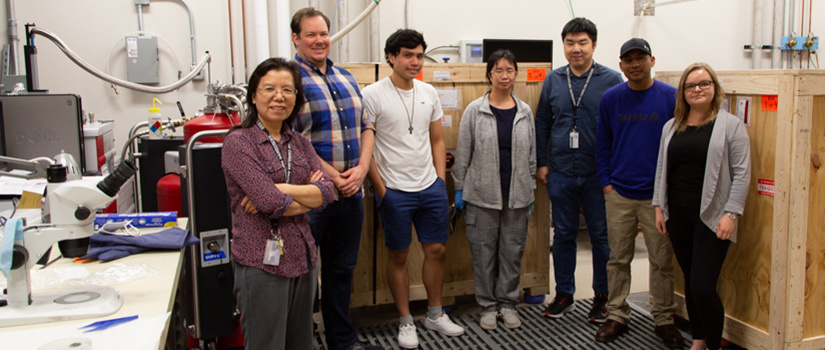Rongyin Jin and her students are creating the computing materials of the future at the University of South Carolina. But this work comes with a uniform.
Before entering their cleanroom, they each pull on paper shoes and a hair cap, followed by a suit that covers them from head to toe, leaving only their faces visible.
Their equipment requires a spotless environment because even a microscopic speck of dust or a stray hair could disrupt the work. Jin handles materials at the nanoscale, where one-third of a nanometer measures a single gold atom. When scientists make something out of an element like gold, working at the nanoscale, they unlock the material’s quantum properties.
To illustrate the precision of the equipment, a postdoctoral fellow displays a portrait of Albert Einstein on a monitor. With the click of a button, a machine called a NanoFrazor Explore hums to life. It etches Einstein’s image onto a surface area smaller than the breadth of a hair.
Einstein’s picture is there, but it requires the computer’s advanced microscopic camera to see. Another student takes the etching to an evaporator, a machine that deposits an incredibly thin layer of precious metal onto the pattern. The team usually tries designs like webs or nets, rather than photos of famous scientists; they then gauge how well each works in quantum computing devices.
Jin’s goal is to discover new materials that can function with barely a trace of energy dissipation – think of the heat created by a laptop, which slows down when it gets too hot. Such materials, known as topological superconductors, will allow quantum computers to function at unimaginable speeds, with the potential to process data in seconds that would take standard computers decades to calculate.
New nanoscale materials could make the technology smaller, faster and more efficient. “If we can get better superconductors which can serve even better function, we can shrink the size and reduce the cost of this technology,” Jin says.
One big factor limits quantum computing ability for now: the current super-conductors
only work at low temperatures, sometimes near absolute zero. Today’s quantum computers
require huge, powerful pieces of equipment to sustain such low temperatures, making
their applications largely out of reach.
The cost and size of quantum computing technology are prohibitive for all but the most specialized uses and research. Jin hopes to change that.
“It’s very important to every aspect of our future, like national defense, homeland security, climate change, you name it,” Jin says.
The federal government agrees with Jin about the technology’s importance. In 2018, Congress passed the National Quantum Initiative Act, which gives the United States a plan to accelerate development of this technology.
She compares the quest for a better computer to the difference between the hallway-filling computers of the earliest days of the technology and the relatively tiny, touchscreen tech that has put computing capability literally right at hand.
“Even ten years ago, you would not have dreamed of the functionality of the smart watch you’re wearing right now!” Jin says.
The journey to quantum research in South Carolina
Jin has been a longstanding leader in the materials field. For more than a decade, she worked at Louisiana State University to build up the institution’s materials program as well as a statewide initiative to advance the technology.
Jin says she was making progress with several prestigious grants and a core team of colleagues who sparked her creativity. Unfortunately, three members of her team passed away unexpectedly over just one year. Jin says she lost close colleagues who were key to continuing the work.
Meanwhile, UofSC was looking for someone to lead the SmartState Center for Experimental Nanoscale Physics after its previous director, Richard Webb, died in 2016.
Jin became the endowed chair of the center in Fall 2021, and the department has been a great match.
“We have the interest, the expertise and the strengths to advance the field of quantum technologies,” she says.
Jin’s colleagues speak highly of the change she has already brought to the physics department.
"Dr. Jin has brought new energy to the SmartState Center for Experimental Nanoscale Physics, and we’re excited to see the progress the team has made in the short time since she joined our faculty,” says Michael Dickson, chair of the physics and astronomy department.
Jin says one of her goals at the center is to establish a good scientific home for herself and her team. With breakthroughs in the research [pdf] she is looking forward to a promising future for quantum materials, with nowhere to go but up.
“Let’s assume this is our bottom line,” she says, “and let’s make each day better than yesterday.”
For Jin, the move to South Carolina has represented a fresh start, and she hopes her arrival has brought a new beginning for the center as well.
“This is why I’m here, and this is why I’m trying to make a positive influence,” Jin says.
